#eofringillirostrum
Text

ITS TIME
FOR
DINOSAUR MARCH MADNESS 2k23!!!!!!!!!!!!
Starting NEXT WEEK, we begin the ultimate competition:
DMM: RISING STARS
These are ALL dinosaurs that have been discovered in the past five years!!! New friends from old times!!! Including such new fan favorites as Bajadasaurus, Jakapil, Meraxes, and Anachronornis - and that's only four of them!
From the weird to the wonderful, these dinosaurs are here to indicate that just because they were found recently, doesn't mean that they aren't destined to become icons like the names we already know and love. Get ready to learn about some new paleontological excitement - and debate angrily over which ones are better ;)
Round One will go from March 1st through the 7th
Round Two will extend from March 8th through the 14th
Round Three will then go from the 15th to the 21st
Round Four from the 22nd to the 28th
And the FINAL FOUR SHOWDOWN (Ornithischian Vs Sauropodomorph vs Nonavian theropod vs Bird) will occur from March 29th through April 4th!
Thanks to the new tumblr poll feature, reconstructions and mini factfiles for each dinosaur will be on the post with the poll itself! No need to leave tumblr, no personal research, no google quizzes - just rapid learning and immediate voting!
Get ready to vote! Get ready to debate! Get ready... for DINOSAUR MARCH MADNESS!
Round One Matchups under the readmore :)
SAUROPODOMORPHA (and miscellany)
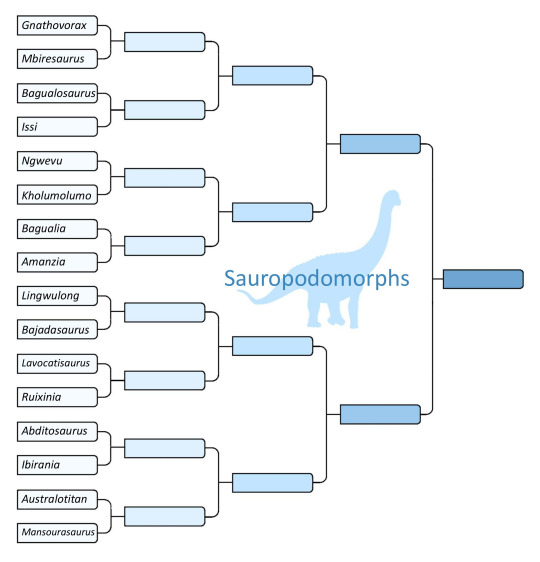
Gnathovorax vs Mbiresaurus
Bagualosaurus vs Issi
Ngwevu vs Kholumolumo
Bagualia vs Amanzia
Lingwulong vs Bajadasaurus
Lavocatisaurus vs Ruixinia
Abditosaurus vs Ibirania
Australotitan vs Mansourasaurus
ORNITHISCHIA
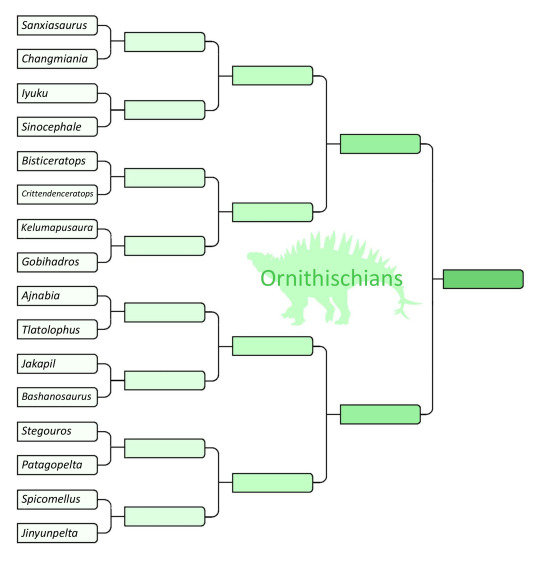
Sanxiasaurus vs Changmiania
Iyuku vs Sinocephale
Bisticeratops vs Crittendenceratops
Kelumapusaura vs Gobihadros
Ajnabia vs Tlatolophus
Jakapil vs Bashanosaurus
Stegouros vs Patagopelta
Spicomellus vs Jinyunpelta
NONAVIAN THEROPODA
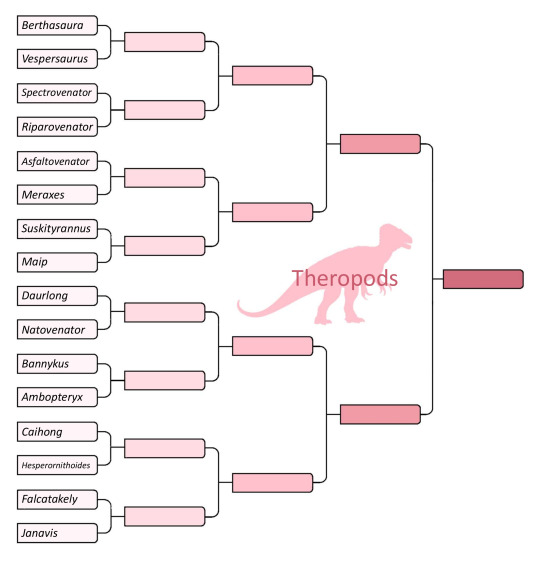
Berthasaura vs Vespersaurus
Spectrovenator vs Riparovenator
Asfaltovenator vs Meraxes
Suskityrannus vs Maip
Daurlong vs Natovenator
Bannykus vs Ambopteryx
Caihong vs Hesperornithoides
Falcatakely vs Janavis
NEORNITHES (BIRDS)

Vorombe vs Prodontopteryx
Asteriornis vs Panraogallus
Anachronornis vs Conflicto
Annakacygna vs Nasidytes
Aviraptor vs Cryptogyps
Miosurnia vs Primoptynx
Danielsraptor vs Heracles
Eofringillirostrum vs Heliothraupis
#dinosaur march madness#dmm#dmm rising stars#palaeoblr#dinosaurs#bracket#polls#march madness#tumblr dinosaur competition#thank you tumblr for making polls dmm is so much easier now I will cry#heliothraupis#eofringillirostrum#heracles#danielsraptor#primoptynx#miosurnia#cryptogyps#aviraptor#nasidytes#annakacygna#conflicto#anachronornis#panraogallus#asteriornis#prodontopteryx#vorombe#janavis#falcatakely#hesperornithoides#caihong
835 notes
·
View notes
Text
this is how it is, how it's been. tumultuous to say the least. they argue, shout at each other. it's been like this since the beginning, but the moments of reprieve, of familial actions, have become less and less, few and far between. dick would rather spend time with alfred than his mentor.
he cannot blame him.

"i don't expect you to bend over backwards for me, dick. but i expect you to LISTEN to what i tell you, when i tell you it." cowl comes off and he turns to face the younger, eyes narrowing in disapproval. "i understand that you are busy," back is turned, he walks away, towards his computer. "but you still have a duty to this city. to me." he's trying to be calm, to not have this turn into one of their shouting matches, to keep things at their usual, unhappy baseline.
a sigh passes his lips. he sounds exhausted, looks exhausted. is exhausted. "i need you to be with me, chum. not against me. i can't do this alone."
@fightwing
2 notes
·
View notes
Photo

A selection of new dinosaurs named in 2019.
#Dinosaurs#Palaeoblr#2019#Birds#Birblr#Heracles#Asfaltovenator#Gnathovorax#Suskityrannus#Convolosaurus#Vespersaurus#Hesperornithoides#Conflicto#Bajadasaurus#Avimaia#Eofringillirostrum#Elektorornis#Ambopteryx#Protodontopteryx
18 notes
·
View notes
Text


Wyoming's Fossil Lake has revealed yet another astonishing find — one of the earliest known passerine birds.
Perching birds, or passerines, include species such as sparrows, finches, robins and crows. All told the birds with feet made for hanging onto limbs make up about 6,500 of the 10,000 bird species alive today.
That wasn't always the case. They were once rare, and scientists are still learning about their origins.
Fifty-two million years ago, in a period known as the Early Eocene, one of these then-rare birds was preserved in sediment in southwest Wyoming's Green River geologic formation.
"This is one of the earliest known perching birds," said Lance Grande, Field Museum Neguanee Distinguished Service Curator. "It's fascinating because passerines today make up most of all bird species, but they were extremely rare back then. This particular piece is just exquisite. It is a complete skeleton with the feathers still attached, which is extremely rare in the fossil record of birds."
Grande is one of the authors of a new paper published in "Current Biology" that describes two new fossil bird species — one from Germany that lived 47 million years ago, and the other that lived in what's now Wyoming.
The Wyoming bird, Eofringillirostrum boudreauxi, is the earliest example of a bird with a finch-like beak, similar to today's sparrows and finches. This legacy is reflected in its name; Eofringilllirostrum means "dawn finch beak." Meanwhile, boudreauxi is a nod to Terry and Gail Boudreaux, longtime supporters of science at the Field Museum.
The fossil birds' finch-like, thick beaks hint at their diet.
"These bills are particularly well-suited for consuming small, hard seeds," said Daniel Ksepka, the paper's lead author and curator at the Bruce Museum in Connecticut.

Researchers in the field at Fossil Lake, Wyoming, pry up a slab of rock containing fossils. Photo courtesy Lance Grande, Field Museum▲
Anyone with a bird feeder knows that lots of birds are nuts for seeds, but seed-eating is a fairly recent biological phenomenon.
"The earliest birds probably ate insects and fish, some may have been eating small lizards," Grande said. "Until this discovery, we did not know much about the ecology of early passerines. E. boudreauxi gives us an important look at this."
"We were able to show that a comparable diversity of bill types already developed in the Eocene in very early ancestors of passerines," said co-author Gerald Mayr of the Senckenberg Research Institute in Frankfurt.
"The great distance between the two fossil sites implies that these birds were widespread during the Eocene, while the scarcity of known fossils suggests a rather low number of individuals," Ksepka added.
While passerine birds were rare 52 million years ago, E. boudreauxi had the good luck to live and die near Fossil Lake, a site famous for perfect fossilization conditions.
"Fossil Lake is a really graphic picture of an entire community locked in stone — it has everything from fishes and crocs to insects, pollen, reptiles, birds, and early mammals," Grande said. "We have spent so much time excavating this locality that we have a record of even the very rare things."
Grande noted that Fossil Lake provides a unique look at the ancient world — one of the most detailed pictures of life on Earth after the extinction of the dinosaurs (minus the birds) 65 million years ago.
"Knowing what happened in the past gives us a better understanding of the present and may help us figure out where we are going for the future," he said.
With that in mind, Grande plans to continue his exploration of the locale.
"I've been going to Fossil Lake every year for the last 35 years, and finding this bird is one of the reasons I keep going back," Grande said. "It's so rich. We keep finding things that no one's ever seen before."
12 notes
·
View notes
Text
Earliest known seed-eating perching bird discovered in Fossil Lake, Wyoming
http://eqonlinenews.com/2019/02/10/earliest-known-seed-eating-perching-bird-discovered-in-fossil-lake-wyoming/
In the United States, well-preserved fossils of an ancient bird that could peck hard seeds were found, according to Current Biology. This is indicated by its beak, which resembles a beak. Eofringillirostrum boudreauxi, as the bird was called, lived about 52 million years ago.
The shape of the beak played an important role in the emergence of different species of birds, so when studying the evolution of birds, researchers first of all pay attention to this feature. Perhaps the most closely associated with the study of the shape of the beak is the passer-shaped – the most numerous order of birds, which includes about 5.4 thousand species. The variety of beak shape allows passerine to catch insects, eat carrion, peck hard seeds and drink nectar from flowers. However, the evolution of the beak in passerines has not been studied as yet, since researchers rarely find their fossils.
In a new study, paleontologists Daniel Ksepka and Lance Grande from the Field Natural History Museum and Gerald Mayr from the Zenkenberg Research Institute describe two ancient passerine fossils. Scientists attributed them to one genus and two new species. The fossils of one of the birds were found in Wyoming in the Green River sediments. Eofringillirostrum boudreauxi, as scientists called it, lived in the Middle Eocene, about 52 million years ago. The remains of the second bird, Eofringillirostrum parvulum, were found in southwest Germany. She was much younger than E.boudreauxi and lived about 47 million years ago. In size, both birds were similar to the Canadian nuthatch – about 11 centimeters in length and weighed about ten grams. E.boudreauxi was slightly larger than E.parvulum.
The birds had a short upper part of the beak of conical shape, which narrowed to a thin tip. In appearance, it resembled the beak of a modern American chizh, which feeds on seeds, including sunflower seeds. “These beaks are well adapted to feed on small, hard seeds,” says Daniel Ksepka. “The most ancient birds, apparently, fed on insects and fish. Some may have eaten little lizards. Prior to this discovery, we knew little about the ecology of early passer-shaped birds. E.boudreauxi gives us important information about her. ”
Previously, ornithologists had attracted volunteers to study the evolution of bird beaks. Scientists conducted a 3D-scan of the beaks of more than two thousand species of birds and laid out models on the site, and volunteers marked them out.
0 notes
Text
This bird kept its feathers for 52 million years
This bird kept its feathers for 52 million years
Scientists discover a fossil in Wyoming of Eofringillirostrum boudreauxi, a 52-million-year-old bird with its feathers intact.
View On WordPress
0 notes
Text
This bird kept its feathers for 52 million years
Scientists discover a fossil in Wyoming of Eofringillirostrum boudreauxi, a 52-million-year-old bird with its feathers intact.
from The Latest from MNN - Mother Nature Network http://bit.ly/2TLVntZ
via IFTTT
0 notes
Text
Earliest known seed-eating perching bird discovered in Fossil Lake, Wyoming - Phys.org
Earliest known seed-eating perching bird discovered in Fossil Lake, Wyoming – Phys.org
[ad_1]
The 52-million-year-old fossil of Eofringillirostrum boudreauxi, the earliest known perching bird with a beak for eating seeds. Credit: (c) Lance Grande, Field Museum
Most of the birds you’ve ever seen—sparrows, finches, robins, crows—have one crucial thing in common: they’re all what scientists refer to as perching birds, or “passerines.” The…
View On WordPress
0 notes
Text
Eofringillirostrum vs Heliothraupis
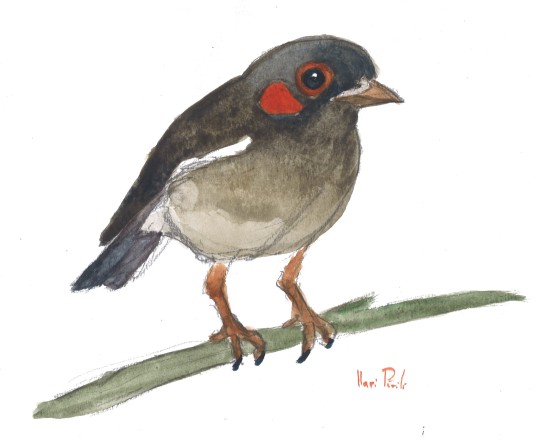
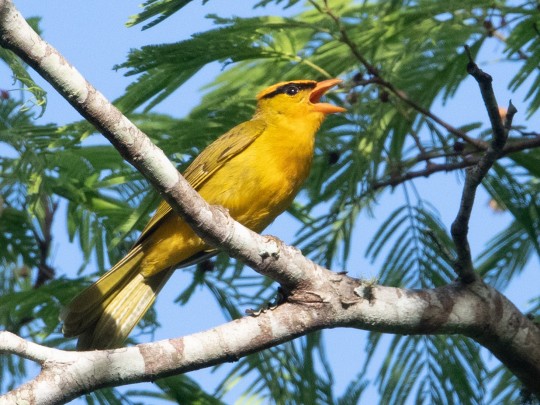
Factfiles:
Eofringillirostrum boudreauxi, E. parvulum

Artwork by @otussketching, written by @zygodactylus
Name Meaning: Dawn Finch-Beak (Boudreaux’s or Small)
Time: 54 to 48 million years ago, in the Ypresian of the Eocene
Location: Sandwich Beds, Fossil Butte Member, Green River Formation, Wyoming; and the Messel Formation near Darmstadt, Germany
Today, over half of the birds known in the world are passerines, or “perching birds”. Unfortunately, these birds on average are small and delicate, leading to their not having the most robust fossil record compared to other birds. However, the fossils of passerines we do have tell us an interesting story about their evolution. Eofringillirostrum, despite being a very early member of the total-passeriform group (ie, it isn’t a true passerine, but close), shows how many of the traits we see in modern representatives occurred fairly early on in their evolution. Eofringillirostrum had a finch-like beak, similar to living species, that would have been helpful in eating small hard seeds - a niche not easily exploited. While we often think of birds as “seed-eaters”, this is not common and only exploitable by certain species - and, apparently, some early passerine relatives like Eofringillirostrum. This indicates that different early relatives of passerines were already doing very similar ecological jobs to their living relatives, even while many other bird types were exploiting passerine-like niches (such as the many types of stem-mouse birds that lived at the time). Both the Messel Pit and the Fossil Butte environments were tropical forests, emerging right after the Paleocene-Eocene Thermal Maximum; both were associated with fossil lakes, which allowed for rapid preservation of a variety of early animals that show how “modern” life first diversified in the Paleogene period. As such, Eofringillirostrum just has too many neighbors to list - including so many kinds of birds its a little overwhelming. Eofringillirostrum, in this environment, would have been one of many different species of birds, and weirdly modern looking among them!
Heliothraupis oneilli

Photograph by John C. Mittermeier, written by @zygodactylus
Name Meaning: O’Neill’s Tanager of the Sun God Inti
Time: Unknown to the present, Holocene, Quaternary
Location: Western Bolivia and Southern Peru, South America
Rarely do we get to talk about a newly discovered living species of bird, but this is one of those excellent times! This bird, a bright yellow tanager with a distinctive black stripe across its eye, was found in the Neotropics - specifically in the Yungas region. Given that Latin America has the largest number of bird species in the world, it makes a certain amount of sense that we may have missed some! First spotted in the nineties, it was properly identified and described over the course of the 2010s. The distinctive appearance of this tanager lead to it being nicknamed the “Kill Bill Tanager”, in reference to its similarity to Uma Thurman’s yellow jumpsuit outfit. Distinct in appearance and population from other tanagers, it was deemed not only a separate species, but an entirely separate genus. It is migratory, breeding in the northern Machariapo Valley and going down to the eastern Andes for the nonbreeding season. It lives in deciduous forests, and breeds in bamboo grasses. It is a loud and vocal bird, making distinctive songs and choruses that happen long after the dawn chorus of most other birds. As it lives in a fairly isolated region of these countries, its habitat is not particularly threatened at this time.
DMM Round One Masterpost
#dmm#dinosaur march madness#dinosaurs#birds#dmm round one#dmm rising stars#birblr#palaeoblr#paleontology#bracket#march madness#polls#eofringillirostrum#heliothraupis
161 notes
·
View notes
Note
Trick or treat !!!!!!
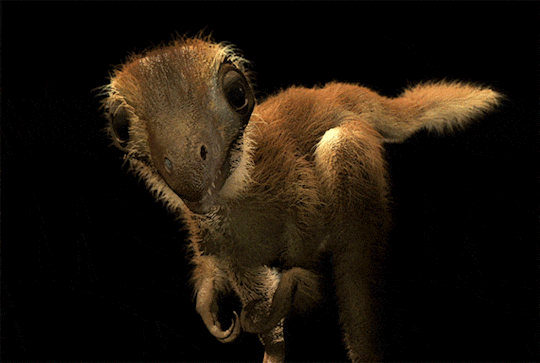
A floof gif!

Eofringillirostrum by @otussketching!
32 notes
·
View notes
Text
Fossil Novembirb 9: Getting a Grip

Zygodactylus by @thewoodparable
Today, half of all birds - so half of all living dinosaurs - are in a clade called Passeriformes, aka "Perching Birds". Of course, not all birds that perch are in this clade, but what can you do. With three toes forward and one long toe facing back, these animals can easily perch upright on branches and have tendons in their legs to help stiffen their grip while sleeping, enabling them to stay put!
But where did this giant group get started?
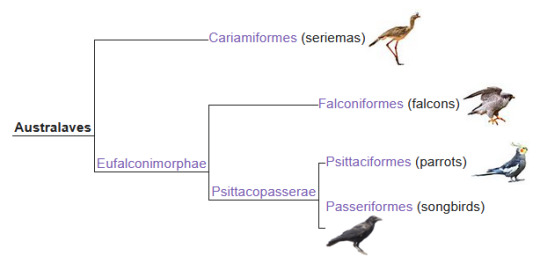
Australaves phylogenetic tree from Wikipedia
For a while, the prevalent idea was that they evolved from similar birds that perch in trees, such as pigeons and swifts. However, genetic evidence showed that the closest relatives of passerines were actually... parrots! And their closest relatives are Falcons, and just outside of that, Seriemas! What a wild twist!
Of course, paleontologists - being paleontologists - wanted to find the fossil evidence of this evolution. Luckily, as the genetic picture became clear, so did the fossil one - a handful of fossil birds that were mysteries before suddenly became clear, and more and more are being found as time goes on.
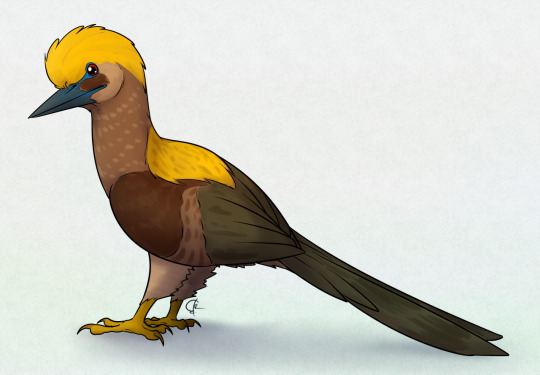
Primozygodactylus by @quetzalpali-art
In the Early Eocene, many of these early Passerine-Parrot relatives existed, and showcase a fascinating stepwise evolution of Passerine characteristics - namely, the feet. While the smaller head and size of Passerines evolved first, and show up in early relatives such as Zygodactylus, the foot arangement? Not so much. Instead, these animals had the bodies of passerines, and the feet of parrots! This indicates that the skinny legs and specialized wing shape of Passerines evolved first, and the special feet second. Truly, this and the many other stem-passerines we have found with this configuration qualify as "Evolutionary Missing Links". Dinosaurs remain our best way to show how evolution has happened over time! But I digress.
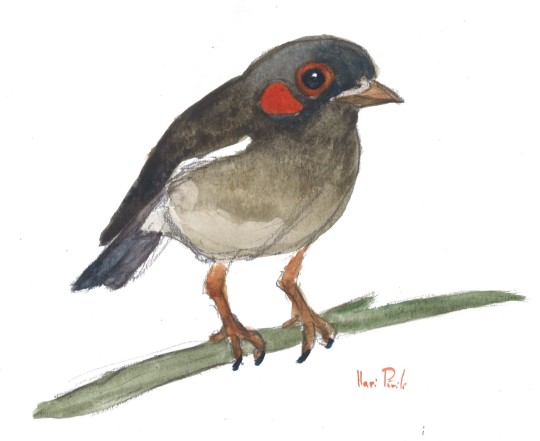
Eofringillirostrum by @otussketching
From these animals eventually came Passerines, though they were not especially common to begin with - many other birds lived in trees too, such as Mousebirds, and like all great dynasties, Passerines needed time to get started. That doesn't mean they weren't around - Eofringillirostrum, one of the smallest fossil dinosaurs we have, was already living kind of like a modern finch, without being closely related to them!
What's weird, however, is that most of our earliest known passerine and stem-passerine fossils are from North America and Europe. This is, however, a sampling bias - we just have spent more time looking for fossils in these locations. The "most basal" (ie, earliest-branching) passerines and parrots are both found in Aotearoa today - indicating that this clade probably diverged and first appeared somewhere in Oceania. Hopefully, fossils of these early Passerine-Parrots will be found in the region soon!
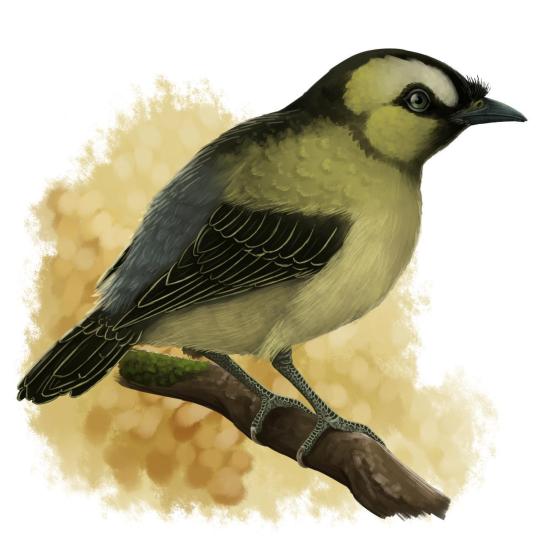
Wieslochia by @drawingwithdinosaurs
Alas, Passerine fossils of any kind do not become particularly common until the early Miocene, indicating that the climate change occurring globally at the time did allow Passerines to diversify more than they had previously. Perhaps Passerines were more adaptable to colder and drier climates than other tree birds had been, or their specialized perching feet allowed them to live easier in different types of forests. By the late Miocene, modern genera were even appearing. Though these delicately boned dinosaurs do not fossilize easily, more and more of the puzzle is showcasing how we got to the point where half of all living dinosaurs belong to this group.
In fact, thanks to genomics, we have something of an idea as to why Passerines speciate at the drop of a hat - and that reason is recombination! For some reason, Passeriformes are more prone to genomic restructuring and shuffling, with even short periods of separation between populations leading to rapid accumulation of these genomic architectural differences. Between that and the variety of ecologies such small arboreal animals can inhabit, it was just a perfect set of conditions for so many species to evolve - and honestly? I doubt Passeriformes are going anywhere any time soon.
Sources:
Conway, M., B. J. Olsen. 2019. Contrasting drivers of diversification rates on islands and continents across three passerine families. Proceedings of the Royal Society B 286(1915): 20191757.
Gibb, G. C., R. England, G. Hartig, P. A. McLenachan, B. L. Taylor Smith, B. J. McComish, A. Cooper, D. Penny. 2015. New Zealand Passerines Help Clarify the Diversification of Major Songbird Lineages during the Oligocene. Genome Biology and Evolution 7(11): 2983-2995.
Manthey, J. D., J. Klicka, G. M. Spellman. 2021. The Genomic Signature of Allopatric Speciation in a Songbird is Shaped by Genome Architecture (Aves: Certhia americana). Genome Biology and Evolution 13(8): evab120.
Mayr, G., A. C. Kitchener. 2022. Psittacopedids and zygodactylids: the diverse and species-rich Psittacopasserine birds from the early Eocen London Clay of Walton-on-the-Naze (Essex, UK). Historical Biology 35 (12): 2372-2395.
Mayr, 2022. Paleogene Fossil Birds, 2nd Edition. Springer Cham.
Mayr, 2017. Avian Evolution: The Fossil Record of Birds and its Paleobiological Significance (TOPA Topics in Paleobiology). Wiley Blackwell.
Mayr, G. and A. Manegold. 2006. New specimens of the earliest European passeriform bird. Acta Palaeontologica Polonica 51(2):315-323.
139 notes
·
View notes
Text
Fossil Novembirb 10: Bayou in the Badlands

Fluvioviridavis by @quetzalpali-art
Back to Eocene Ecosystems! One of the most famous Eocene fossil sites in the world is the Fossil Lake site of the Green River Formation, an ecosystem from Colorado in the United States. This ecosystem records the transition from the moist forested world of the early Eocene to the drier warm world of the mid-Eocene. The forests would begin to shrink back, the foliage would change, and so would the animals.
Fossil Lake records the start of that process! Sediment would regularly settle into this lake at periodic intervals, which then recorded the evolution of the lifeforms there over thousands of years. The forests were filled with sycamore trees and other broadleaf plants, as well as ferns.

Limnofregata by @iguanodont
Because the lake was so frequently filled with sediment, oxygen levels were low to nonexistent, preventing decomposers from living at the bottom of the lake. This lead to many different organisms being preserved nearly perfectly, including many gorgeous birds!
In fact, the Field Museum of Chicago - my home - has many of these wonderful fossils on display, and have fascinated me since childhood. So I'm going to break format a little here to showcase some of these fossils.

Cyrilavis, a Halcyornithid (Parrot-Passerine of Prey)
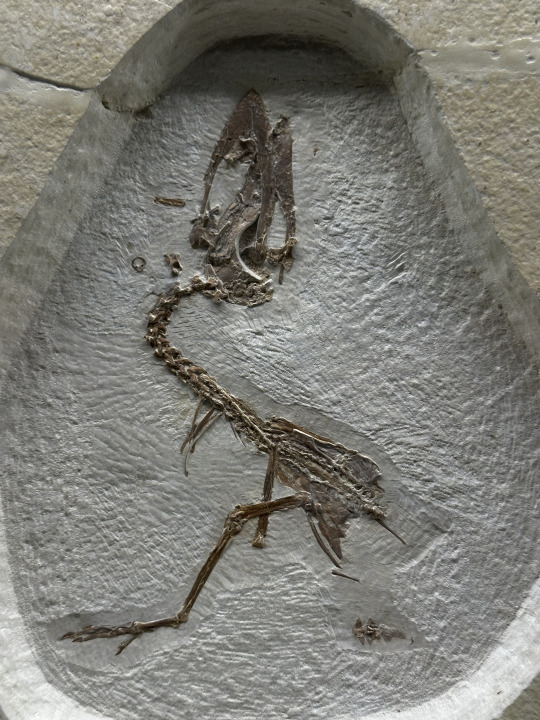
Fluvioviridavis, a Strisorian (like oilbirds or frogmouths)

Eofringillirostrum, a Passerine

Limnofregata, a Frigatebird in a Gull Niche

Nahmavis, a relative of shorebirds (Charadriiformes) or rails and cranes (Gruiformes)
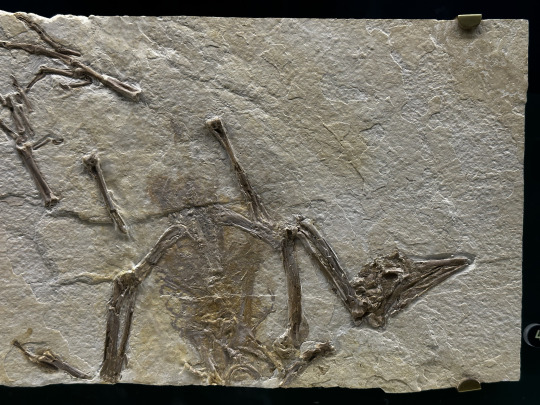
An unnamed Anseriform, probably similar to Anachronornis

Celericolius, a mousebird

Zygodactylus, a stem-passerine
We see once again in this ecosystem - as we have in the others we've covered - the common theme of Avian evolution: the niches may stay the same, but the birds filling them will always change. We have Mousebirds perching in trees in North America, we have Frigatebirds filling the Gull niche, ducks wading around the lake like flamingos, and cousins of parrots/passerines hunting prey.

Presbyornis by @drawingwithdinosaurs
Other notable dinosaurs from this formation include Presbyornis, another one of those Flamingo-Ducks we've talked about like Teviornis and Conflicto; Gastornis because it was literally everywhere from the latest Paleocene through the early Eocene; Lithornithids like Pseudocrypturus because they were also everywhere; early landfowl like Gallinuloides; the cuckoo-roller Plesiocathartes; the ibis Vadaravis; and the turaco relative Foro. Once again, we see many tropical birds in places where they aren't today, due to the extensive warm climate of the Early Eocene.

Foro by @drawingwithdinosaurs
This swampy ecosystem was filled with large crocodile relatives, small mammals, the earliest known bats, giant lizards, and an alarming number of fish - making it one of the better known ecosystems of the early Paleogene. But the best known Paleogene fossil location is still to come...
Sources:
Grande, L. 2013. The Lost World of Fossil Lake: Snapshots from Deep Time. University of Chicago Press.
Mayr, 2022. Paleogene Fossil Birds, 2nd Edition. Springer Cham.
Mayr, 2017. Avian Evolution: The Fossil Record of Birds and its Paleobiological Significance (TOPA Topics in Paleobiology). Wiley Blackwell.
79 notes
·
View notes
Photo
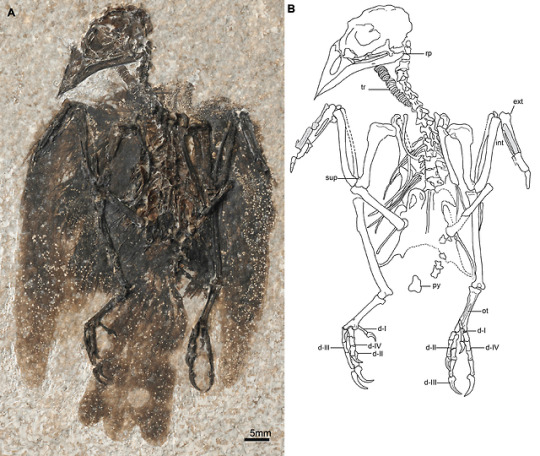
There were no finches or sparrows 50 million years ago. However, a new discovery shows that there was a different sort of seed-eating bird, Eofringillirostrum! I write more about it here.
Image from Ksepka et al. (in press).
339 notes
·
View notes
Photo
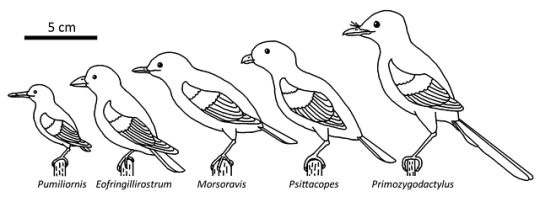
Passerines represent 60% of modern bird diversity today, but we haven't found any fossils of them from the Eocene. Instead, their close relatives took up many of the niches that they would fill in the future. Unfortunately, by the middle Miocene, most of these stem-passerines had become extinct.
Full view
#Palaeoblr#Birblr#Birds#Dinosaurs#Passerines#Pumiliornis#Eofringillirostrum#Morsoravis#Psittacopes#Primozygodactylus
16 notes
·
View notes
Photo

Being me, I naturally decided to modify that 50 characters meme into a “50 interesting dinosaurs” meme. Hats off to you if you can identify more than half from these tiny pixelated images. (Hint: 14 of them are Cenozoic dinosaurs.) Blank version here for anyone else who wants to fill it out.
(Answers below the break.)
Buriolestes
Chilesaurus
Hesperornis
Iteravis
Prenocephale
Kelenken
Kosmoceratops
Aptornis
Concavenator
Limnofregata
Halszkaraptor
Cruralispennia
Falcarius
Microraptor
Haplocheirus
Similicaudipteryx
Foro
Conflicto
Sapeornis
Protodontopteryx
Albertonykus
Limusaurus
Kulindadromeus
Yi
Celericolius
Yutyrannus
Balaur
Xenicibis
Mei
Eofringillirostrum
Anchiornis
Bannykus
Raphus
Borealopelta
Miragaia
Archaeopteryx
Oryctodromeus
Caihong
Eocoracias
Parasaurolophus
Gigantoraptor
Fluvioviridavis
Inkayacu
Mengciusornis
Deinocheirus
Sinocalliopteryx
Eocypselus
Nigersaurus
Shanweiniao
Tianyulong
7 notes
·
View notes